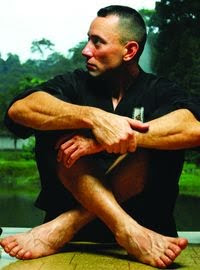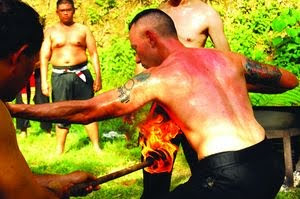
National Geographic Channel’s newest Malaysian documentary delves into the traditional martial art form of silat by tracing one man’s desire to be a fight master.
Navy serviceman Joel Champ can put many Malaysians to shame. While many locals opt to learn foreign martial arts such as Korea’s tae kwon do or Japan’s karate, the 31-year-old American has gone beyond his borders to learn the Melayu traditional art form silat.
The Chicago-lad, who is also an exponent of kick boxing, kempo and has military training, had his heart set on learning silat because of its deadly and mystical qualities.
“My father runs a martial arts school in Chicago, so I was exposed to martial arts from a young age. I was 17 years old when I was first introduced to Malaysian silat guru Sheikh Shamsuddin Sheikh Muhammad Salim (a.k.a. Cikgu Sam). I fell in love after watching his silat demonstration.”
According to Champ, who is featured in National Geographic Channel’s (NGC) Fight Masters: Silat which premieres tonight, silat focuses on strikes, joint manipulation and animal-inspired movements.
“Despite being a little unorthodox, silat seemed to blend a bit of other martial arts forms I had learnt before,” said Champ, 33, in an e-mail interview.
Champ has studied under Cikgu Sam’s tutelage for 15 years now and appreciates the fact that silat has taught him elements of humility and determination.
There are at least 150 known silat forms including Silat Seni Gayong (SSG), Silat Cekak and Silat Melayu Keris Lok 9. In the United States, Cikgu Sam heads the US Silat Seni Gayong Federation and carries the title ketua khalifah (chief of caliph).
Cikgu Sam, who has been residing in Chicago for 25 years, admitted being initially sceptical upon taking Champ under his wing. His concerns were teaching SSG to a foreigner and dealing with cultural differences.
He said in an e-mail interview: “Teaching SSG to someone who is not of Melayu origin is quite challenging, but not impossible.
There are cultural differences that need to be addressed such as adat (culture) and adab (norm). Proper behaviour in Melayu silat is different compared to Japanese or Korean martial arts. For example, silat practitioners do not bow to the instructor, although it is understood when one bows to you – it is nothing more than just a gesture of respect.”
“It is indeed quite complex and tricky to coach someone from a different ethnic background. People from different countries and ethnic backgrounds have diverse cultures and ways of thinking. When they come to class, they bring with them their life experiences, different levels of knowledge and expectations. As an instructor, I have to be open-minded and attempt to comprehend who and what these people are and why they desire to learn silat.”

After teaching Champ, Cikgu Sam is confident anyone who is capable and disciplined can learn SSG.
“Some say that you cannot learn silat unless you are a Muslim. Martial arts and religion are two separate entities. Blending these makes you more conscious outwardly and inwardly. As for the spiritual aspect, one can be guided. It is up to the individual to find the right path,” said Cikgu Sam, author of The Malay Art Of Self-Defense: Silat Seni Gayong, who learnt SSG in 1973. Sam is also trained in Korean and Japanese martial arts hapkido and aikido respectively. During the day he works as a computer network systems administrator.
Thus far, Champ has secured a second degree back belt in silat – the highest any American has attained. In order to get a third degree black belt, Champ – together with Sam – travelled to Kuala Lumpur to test his strength and endurance. Champ’s journey is featured in the hour-long documentary which will be shown tonight as part of the Merdeka Specials programming on the NGC. This is the first of two new made-in-Malaysia full high definition documentaries in partnership with Finas, and third NGC production after Becoming A King (2007) and Smart Tunnel (2008).
Fight Masters: Silat’s director/producer Justin Ong, 30, said the documentary tracks SSG’s origins as well as Champ’s journey learning the new moves from silat fighters.
“There will be new strategies Joel (Champ) has to master, deadly tackles he has to fend against, killer weapons that his American training has never prepared him for. He also has to undergo a series of endurance tests like immersing his hands in a vat of boiling oil. Upon completing these tests, Joel has to battle against a national silat champion to prove he is up to the mark,” said Ong, who admitted to initially having misconceptions about silat, thinking it was a docile martial arts form. He only discovered how intense it was during recording.
“Most Malaysians know what silat is but have a misconception of the art form, thinking its movements are often performed as a dance during festivities such as weddings. While working on the programme, I saw silat in a different light and learnt that it is one of the deadliest art forms. Although it doesn’t place emphasis on elaborate flying kicks, silat is lethal. For a better understanding, the documentary uses motion capture and computer-generated imagery to deconstruct the science behind silat’s powerful moves,” he said.
Fight Masters: Silat premieres on National Geographic Channel (Astro channel 553) tonight (9pm) with repeats on Sept 11 and 15 (9pm).
Sourced from http://www.star-ecentral.com/news/story.asp?file=/2009/8/31/tvnradio/4560525&sec=tvnradio









